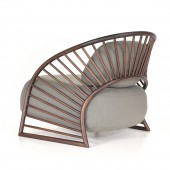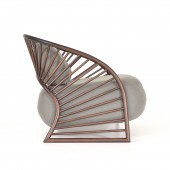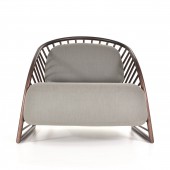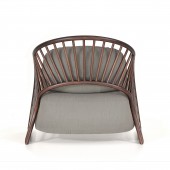
| THE AWARD |
| CATEGORIES |
| REGISTRATION |
| SUBMIT YOUR WORK |
| ENTRY INSTRUCTIONS |
| TERMS & CONDITIONS |
| PUBLICATIONS |
| DATES & FEES |
| METHODOLOGY |
| CONTACT |
| WINNERS |
| PRESS ROOM |
| GET INVOLVED |
| DESIGN PRIZE |
| DESIGN STORE |
| THE AWARD | JURY | CATEGORIES | REGISTRATION | PRESS | WINNERS | PUBLICATIONS | ENTRY INSTRUCTIONS |
Luar Armchair by Lattoog |
Home > Winners > Design #161184 >Interview |
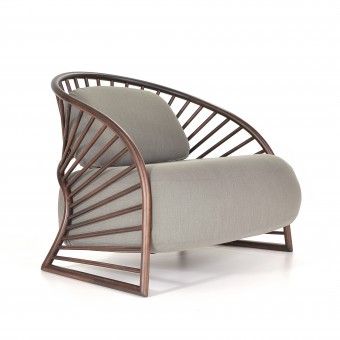 |
|
FS: What is the main principle, idea and inspiration behind your design?
LS: The Luar armchair was born as a result of a three dimensionalization exercise of preexisting and very valuable graphic patterns within the creative process of Lattoog designers: the iconographic modular designs of the stone sidewalks on the shores of Ipanema and Copacabana beaches in Rio de Janeiro, hometown of the designers of this piece. This armchair receives a romantic name in Portuguese: Luar, which means Moonlight in English.
FS: What has been your main focus in designing this work? Especially what did you want to achieve?
LS: We were working to fulfill a request from a manufacturer who was looking for a piece made mainly of wood and with a very peculiar design, with lots of curves. The aim was to create a unique piece that would be difficult for competitors to copy, something that has been a challenge for us lately.
FS: What are your future plans for this award winning design?
LS: Our intention is for the product to be available in the main stores in Brazil initially and then to enter the American and South American markets.
FS: How long did it take you to design this particular concept?
LS: The project started in January 2023 in Rio de Janeiro and was launched in March 2024.
FS: Why did you design this particular concept? Was this design commissioned or did you decide to pursuit an inspiration?
LS: It was designed for a manufacturer, right, who is already a long-standing partner, and who will do the marketing and pay us a royalty on sales.
FS: Is your design being produced or used by another company, or do you plan to sell or lease the production rights or do you intent to produce your work yourself?
LS: It was designed for a manufacturer that has been our partner for a long time, Schuster Furniture, and it will be this company that will take care of the marketing, paying us royalties on sales.
FS: Where there any other designs and/or designers that helped the influence the design of your work?
LS: In this case, we weren't directly inspired by another designer's work. However, we applied a technique that we had previously developed in the Temes Armchair, which we created a few years ago with Schuster Móveis, and this technique has now been reused. The Temes Armchair, in turn, was influenced by Joaquim Tenreiro, a Portuguese designer who lived in Brazil during the modernist era and is considered one of the forerunners of modern Brazilian design.
FS: Who is the target customer for his design?
LS: Normally, our target audience is made up of class A, characterized by high purchasing power and an interest in design. It is also common for this audience to be predominantly female, aged over 40.
FS: What sets this design apart from other similar or resembling concepts?
LS: We aimed to incorporate a narrative deeply linked to Rio de Janeiro, highlighting its beaches, promenades and characteristic architecture, since it is our city. The design is very simplified, consisting only of a curved plane of hollowed-out wood and a large cushion suspended from the ground, with no apparent fittings.
FS: How did you come up with the name for this design? What does it mean?
LS: Inspiration has always been anchored in the Ipanema beach promenade in Rio de Janeiro, a place that is part of our daily lives. That's why we chose a very poetic name, Luar Armchair, which means moonlight in Portuguese and evokes a Brazilian atmosphere and refers to the nature present in the city of Rio de Janeiro.
FS: What is the most unique aspect of your design?
LS: What makes the design unique is a woodworking technique that makes it possible to create delicate, uniform curves without the joints being noticeable.
FS: Who did you collaborate with for this design? Did you work with people with technical / specialized skills?
LS: We collaborated with Schuster Móveis, a manufacturer with whom we have had a partnership for 15 years. And the technique used in the Luar Armchair of molding wood microlaminates was developed with them a decade ago.
FS: Is your design influenced by data or analytical research in any way? What kind of research did you conduct for making this design?
LS: We concentrated on carrying out technical research for the development of the Luar Armchair, exploring and refining the processes directly, in practice, in the factory environment, rather than exclusively developing theoretical studies. We focused on testing and perfecting the technique of working with extremely fine micro-laminates, as well as selecting the right glues, pressing methods and dyes.
FS: How did you decide to submit your design to an international design competition?
LS: We've been following the A' Design Awards for many years, but throughout these 20 years of practice, we've never submitted any of our products. There have been times when we regretted not having submitted other products to the A' Design Award, so we decided to take the time this year to enter the Luar Armchair as we believe it deserves to take part.
FS: Thank you for providing us with this opportunity to interview you.
A' Design Award and Competitions grants rights to press members and bloggers to use parts of this interview. This interview is provided as it is; DesignPRWire and A' Design Award and Competitions cannot be held responsible for the answers given by participating designers.
| SOCIAL |
| + Add to Likes / Favorites | Send to My Email | Comment | View Press-Release |

